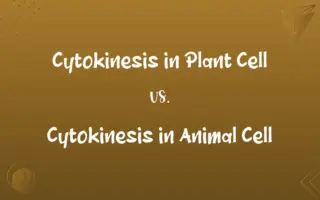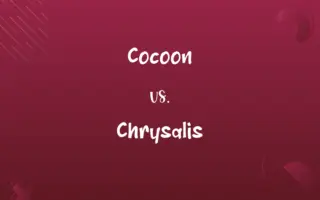Liverworts vs. Mosses: Know the Difference

By Shumaila Saeed || Published on February 12, 2024
Liverworts are non-vascular, flat plants with lobed bodies, while mosses are small, cushiony, vascular plants with distinct stems and leaves.

Key Differences
Liverworts, belonging to the division Marchantiophyta, are small, non-vascular plants typically found in moist environments. They have a flat, lobed thallus and lack true roots, stems, or leaves. In contrast, mosses, which are part of the division Bryophyta, are characterized by their small size but have distinct, tiny leaves, stems, and rhizoids. Mosses also tend to retain more moisture and can be found in a wider range of environments compared to liverworts.
Shumaila Saeed
Feb 12, 2024
Reproductive structures in liverworts are relatively simple and often consist of umbrella-like structures for female organs and stalked structures for male organs. Mosses, however, reproduce via capsules that often sit atop long stalks, called setae, which release spores. This difference in reproductive structures marks a significant distinction between the two groups.
Shumaila Saeed
Feb 12, 2024
Liverworts are known for their ability to clone themselves through gemmae cups, small structures in which asexual reproduction occurs. Mosses typically do not have this capability and rely more on spore-based reproduction. This difference highlights the diverse survival strategies of these primitive plants.
Shumaila Saeed
Feb 12, 2024
In terms of habitat, liverworts are usually found in very wet environments and are more sensitive to drought. Mosses are more adaptable and can survive in slightly drier conditions, making them more common in a variety of habitats, including urban settings.
Shumaila Saeed
Feb 12, 2024
The ecological roles of liverworts and mosses also differ. Liverworts play a crucial role in soil formation and nutrient cycling in wet environments. Mosses, on the other hand, are important for their ability to colonize and stabilize soil, preventing erosion in diverse environments, including forests and tundras.
Shumaila Saeed
Feb 12, 2024
ADVERTISEMENT
Comparison Chart
Vascular System
Non-vascular; lack true vascular tissues
Partially vascular with specialized tissues
Shumaila Saeed
Feb 12, 2024
Plant Structure
Flat, lobed thallus; no true roots, stems, or leaves
Cushiony, with distinct tiny leaves and stems
Shumaila Saeed
Feb 12, 2024
Reproduction
Umbrella-like structures for reproduction; can reproduce asexually through gemmae cups
Capsules on long stalks (setae) for spore dispersal; mainly spore-based reproduction
Shumaila Saeed
Feb 12, 2024
Preferred Environment
Moist environments; sensitive to drought
More adaptable to a range of conditions, including drier environments
Shumaila Saeed
Feb 12, 2024
Ecological Role
Important in soil formation and nutrient cycling in wet environments
Colonize and stabilize soil, prevent erosion in diverse environments
Shumaila Saeed
Feb 12, 2024
ADVERTISEMENT
Liverworts and Mosses Definitions
Liverworts
Small plants with a flat, lobed body structure and no true roots or leaves.
Liverworts thrive on the damp forest floor, contributing to the ecosystem's biodiversity.
Shumaila Saeed
Jan 12, 2024
Mosses
Small, cushiony plants with distinct stems and leaves, part of the division Bryophyta.
The old stone wall was covered in a thick layer of green mosses.
Shumaila Saeed
Jan 12, 2024
Liverworts
Plants that play a significant role in soil formation and nutrient cycling in wetlands.
Liverworts are essential in maintaining the health of the wetland ecosystem.
Shumaila Saeed
Jan 12, 2024
Mosses
Plants with a partial vascular system, often found in moist, shaded areas.
Mosses covered the forest floor, creating a soft green carpet under the trees.
Shumaila Saeed
Jan 12, 2024
Liverworts
Primitive, non-vascular plants typically found in moist environments.
The stream was bordered by a lush carpet of liverworts.
Shumaila Saeed
Jan 12, 2024
ADVERTISEMENT
Mosses
Plants that reproduce via spores released from capsules atop long stalks.
In spring, the mosses released their spores, perpetuating their life cycle.
Shumaila Saeed
Jan 12, 2024
Liverworts
Plants capable of asexual reproduction through structures called gemmae cups.
The liverworts reproduced rapidly in the shaded area, using their gemmae cups.
Shumaila Saeed
Jan 12, 2024
Mosses
Ecologically important for colonizing and stabilizing soil, preventing erosion.
Mosses played a key role in stabilizing the hillside and preventing soil erosion.
Shumaila Saeed
Jan 12, 2024
Liverworts
Members of the division Marchantiophyta, often used in studies of plant evolution.
Botanists study liverworts to understand the early stages of plant development.
Shumaila Saeed
Jan 12, 2024
Mosses
Hardy plants capable of surviving in various environments, including urban areas.
Mosses grew between the city sidewalk cracks, adding a touch of nature to the urban landscape.
Shumaila Saeed
Jan 12, 2024
Liverworts
Any of numerous small, green, nonvascular plants of the division Marchantiophyta, growing in moist environments and consisting of either a leafy mosslike structure or a flat thallus that is often lobed.
Shumaila Saeed
Jan 11, 2024
Mosses
Any of various green, usually small, nonvascular plants of the division Bryophyta, having leaflike structures arranged around the stem and spores borne in a capsule.
Shumaila Saeed
Jan 11, 2024
Mosses
Any of various other unrelated plants having a similar appearance or manner of growth, such as Irish moss, Spanish moss, and the club mosses.
Shumaila Saeed
Jan 11, 2024
Repeatedly Asked Queries
How do liverworts reproduce?
Through umbrella-like structures and asexually via gemmae cups.
Shumaila Saeed
Feb 12, 2024
What is the habitat preference of liverworts?
Prefer very wet environments and are sensitive to drought.
Shumaila Saeed
Feb 12, 2024
What are the ecological roles of liverworts?
Crucial in soil formation and nutrient cycling in wetlands.
Shumaila Saeed
Feb 12, 2024
How do mosses reproduce?
Mainly through spores released from capsules on long stalks called setae.
Shumaila Saeed
Feb 12, 2024
Do liverworts have roots?
No, they lack true roots and have a flat body structure.
Shumaila Saeed
Feb 12, 2024
What are liverworts?
Primitive, non-vascular plants found in moist environments, with a flat, lobed structure.
Shumaila Saeed
Feb 12, 2024
What environments do mosses prefer?
Adaptable to a range of conditions, including moist, shaded, and slightly drier areas.
Shumaila Saeed
Feb 12, 2024
What are the ecological roles of mosses?
Important in colonizing and stabilizing soil, preventing erosion in various environments.
Shumaila Saeed
Feb 12, 2024
How do liverworts differ from mosses?
Liverworts have a flat thallus and reproduce differently, while mosses have distinct stems and leaves and are more adaptable to dry conditions.
Shumaila Saeed
Feb 12, 2024
Can mosses survive in urban areas?
Yes, they are hardy and can grow in urban settings, including on walls and sidewalks.
Shumaila Saeed
Feb 12, 2024
How long have liverworts and mosses existed?
Both have existed for millions of years, dating back to ancient times.
Shumaila Saeed
Feb 12, 2024
Do liverworts have flowers?
No, they do not produce flowers and reproduce through spores or asexually.
Shumaila Saeed
Feb 12, 2024
What are mosses?
Small, cushiony plants with a partial vascular system, belonging to the division Bryophyta.
Shumaila Saeed
Feb 12, 2024
Are liverworts used in research?
Yes, they are studied for insights into plant evolution and development.
Shumaila Saeed
Feb 12, 2024
Can liverworts and mosses be used in gardens?
Yes, they are often used in gardens for ground cover and decoration.
Shumaila Saeed
Feb 12, 2024
Can mosses grow on rocks?
Yes, mosses can grow on rocks, trees, and other surfaces.
Shumaila Saeed
Feb 12, 2024
Are mosses evergreen?
Many moss species are evergreen, maintaining their color throughout the year.
Shumaila Saeed
Feb 12, 2024
Are liverworts similar to mosses?
They share similarities as non-vascular plants but have distinct structures and reproduction methods.
Shumaila Saeed
Feb 12, 2024
Do mosses need a lot of water?
They prefer moist environments but can tolerate periods of dryness.
Shumaila Saeed
Feb 12, 2024
Share this page
Link for your blog / website
HTML
Link to share via messenger
About Author
Written by
Shumaila SaeedShumaila Saeed, an expert content creator with 6 years of experience, specializes in distilling complex topics into easily digestible comparisons, shining a light on the nuances that both inform and educate readers with clarity and accuracy.































































